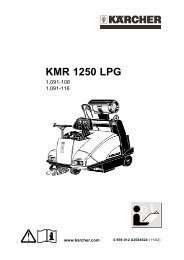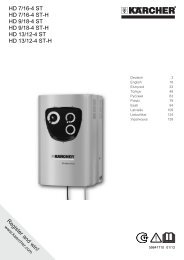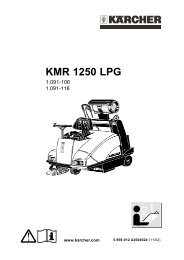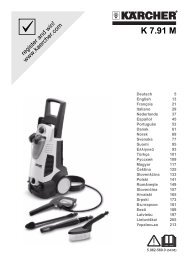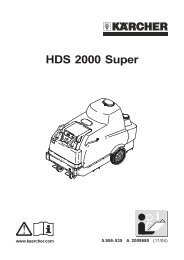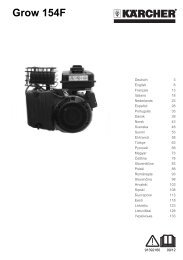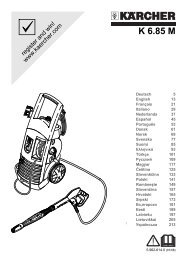HKF 200 - Karcher
HKF 200 - Karcher
HKF 200 - Karcher
You also want an ePaper? Increase the reach of your titles
YUMPU automatically turns print PDFs into web optimized ePapers that Google loves.
Please read and comply with<br />
these original instructions prior<br />
to the initial operation of your appliance and<br />
store them for later use or subsequent owners.<br />
– Before first start-up it is definitely necessary<br />
to read the operating instructions<br />
and safety indications Nr. 5.951-949!<br />
– In case of transport damage inform vendor<br />
immediately<br />
Contents<br />
Environmental protection 19<br />
Symbols in the operating instructions 19<br />
Proper use 19<br />
Function 19<br />
Safety instructions 20<br />
Technical specifications 23<br />
Start up 32<br />
Operation 32<br />
Shutting down 32<br />
Maintenance and care 32<br />
Troubleshooting 33<br />
Accessories 34<br />
CE declaration 34<br />
Warranty 34<br />
Environmental protection<br />
The packaging material can be<br />
recycled. Please do not throw<br />
the packaging material into<br />
household waste; please send<br />
it for recycling.<br />
Old appliances contain valuable<br />
materials that can be recycled;<br />
these should be sent for<br />
recycling. Batteries, oil, and<br />
similar substances must not<br />
enter the environment. Please<br />
dispose of your old appliances<br />
using appropriate collection<br />
systems.<br />
Notes about the ingredients (REACH)<br />
You will find current information about the<br />
ingredients at:<br />
http://www.karcher.de/de/unternehmen/<br />
umweltschutz/REACH.htm<br />
Symbols in the operating instructions<br />
Danger<br />
indicates an immediate threat of danger.<br />
Failure to observe the instruction may result<br />
in death or serious injuries.<br />
Warning<br />
indicates a possibly dangerous situation.<br />
Failure to observe the instruction may result<br />
in light injuries or damage to property.<br />
Note<br />
indicates useful tips and important information.<br />
– The interior cleaners <strong>HKF</strong> <strong>200</strong> are spray<br />
devices to clean drums, containers and<br />
tankers.<br />
– The cleaning head is inserted into the<br />
container through an opening with a<br />
suitable minimum inner diameter.<br />
Cleaning head<br />
Proper use<br />
<strong>HKF</strong> <strong>200</strong> ET, <strong>HKF</strong> <strong>200</strong><br />
PT<br />
<strong>HKF</strong> <strong>200</strong> E, <strong>HKF</strong> <strong>200</strong><br />
C, <strong>HKF</strong> <strong>200</strong> P<br />
<strong>HKF</strong> <strong>200</strong> C2<br />
Minimum container<br />
opening<br />
140 mm<br />
<strong>200</strong> mm<br />
300 mm<br />
– The interior cleaner <strong>HKF</strong> <strong>200</strong> PU is intended<br />
for stationary use. For this, it<br />
must be installed tightly and upright in a<br />
"dome" with a flange. The containers to<br />
be cleaned are placed over the top of<br />
the interior cleaner (installation see<br />
measuring sheet and installation example<br />
<strong>HKF</strong> <strong>200</strong> PU).<br />
– A separate high pressure pump is connected<br />
to the interior cleaner via a high<br />
pressure hose.<br />
Note<br />
The chapter "Specifications" contains a list<br />
of the permitted cleaning liquids.<br />
Operation outside closed containers and<br />
with higher pressure and temperatures than<br />
those listed in the "Specifications" is prohibited.<br />
Please do not allow cleaning liquids to<br />
enter the environment. Protect the<br />
ground and dispose of used oil in an environmentally-clean<br />
manner.<br />
Please do not let mineral oil contaminated<br />
waste water reach soil, water or the<br />
sewage system.<br />
Function<br />
– The interior cleaner consists of a drive<br />
unit, a support pipe and the cleaning<br />
head. The nozzles on the cleaning head<br />
turn around two axles and therefore<br />
touch every place in the container.<br />
– The cleaning head is turned by an electric<br />
or compressed air motor. The speed<br />
is independent of the pressure and the<br />
volume of cleaning liquid. With electric<br />
drives, the speed can be set to either<br />
constant or two-level, with compressed<br />
air drives, the speed can be adjusted via<br />
the compressed air.<br />
English 19






